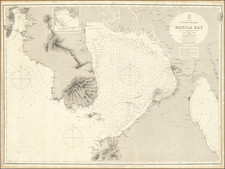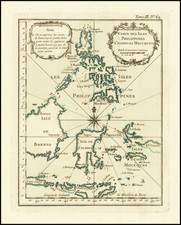Portrait of Phillip V engraved by Francisco Suarez, a native Filipino-one of the first examples of an indigenous printed work in the Philippines
This engraved portrait shows an imperious Phillip V mid-way through his second reign. It was made by Francisco Suarez, one of the most famous of the indigenous artists of the Spanish-controlled Philippines. The present engraving is one of the earliest examples of printed art by a native of the Philippines.
The oval portrait of Phillip V shows him in the typical dress of a privileged man of his day: linen shirt with a flowing cravat, overcoat with layered collar and epaulettes, full wig, and flowing, feathered tricorn. Fleur-de-lis frame the portrait, a nod to Phillip's French origins, while a ribbon proclaims the monarch's name and title (above): Phillip V, "King of the Spanish, Emperor of the Indies." Another banner offers praise (below): " te solis ab ortu, solis ad occa sum laud at uter que polus (from the rising of the sun, to the setting of the sun, I laud [you] at either pole)." The portrait is supported by two pillars. Below, a ship, perhaps one of the galleons of the Manila-Acapulco silver trade, in full sail traverses a choppy sea.
The pillars have their own ribbons proclaiming, " plus ultra (further beyond)." Plus ultra is the motto of Spain. It was adopted during the reign of Charles V in the early sixteenth century. Supposedly, Charles V was attracted to story of the Pillars of Hercules, which guarded the Strait of Gibraltar. The pillars were emblazoned with the words, " nec plus ultra (nothing farther beyond)." Charles inverted the motto for his Spanish empire that was pushing ever farther into the seas. The motto and the pillars were both incorporated into the emblem and flag of Spain.
Phillip V as King of Spain and Emperor of the Indies
Phillip was born in 1683. He was the grandson of the King of France, Louis XIV of France, known as the Sun King. Phillip was the second son of his father, the Grand Dauphin of France. His father and older brother, the Duke of Burgundy, had more direct claims to the Spanish throne when it fell vacant in 1700, but they could not be displaced from their place in the French succession. Thus, when Charles II of Spain died childless in 1700, he named his half-sister's second grandson, Phillip, as his heir. With Phillip on the throne, the kingdoms of France and Spain were dangerously close, triggering fears in the rest of the European monarchs and leading to the War of the Spanish Succession. In 1714, the Treaty of Utrecht forbade the unification of the thrones yet left Phillip as the Spanish King.
For reasons that are not entirely clear, Phillip abdicated in favor of his son in 1724. However, the young King Louis of Spain died of smallpox only seven months into his reign. His father returned to the throne and ruled until his death in 1746.
Most of Phillip's reign was focused on European politics. However, his is the beginning of the Bourbon dynasty which was to have a major impact on the colonies later in the eighteenth century. Phillip himself also had some effect on the empire in the Americas and across the Pacific, as this engraving attests.
The Spanish Empire in the Philippines
The Spanish invaded the Philippines in 1521 and would maintain a presence there until 1898. The first Spanish presence was that of Ferdinand Magellan and his ships, Victoria, Concepción, and Trinidad. Magellan, in an attempt to establish a Spanish trading foothold, became involved in local conflicts and was killed on Mactan Island. Despite a less than promising start, the Spanish sent five more voyages between the 1520s and 1560s.
The final of these, led by Legazpi and Urdaneta, established the circuit from Mexico to the Philippines by 1565. In 1570, the Spanish seized Maynila, renamed it Manila, and made it the western node of the transport of silver from the Americas to Asia-the Manila-Acapulco galleon trade. With the treasure route solidified, Manila and the Philippines became central to the Spanish colonial project.
Far from reinforcements, the Spanish also endured near-constant rebellions from the indigenous peoples, as well as attacks by Chinese pirates, and Dutch and Portuguese traders. Nevertheless, certain European practices were adopted in the colony, including engraving and printing.
Printing in the Philippines and Francisco Suarez
In 1593, Father Domingo de Nieva built the first printing press in the Philippines with help from a Chinese printer, Keng Yong. Many of the earliest printed works were prayer books and grammars; the first was a Spanish-Tagalog catechism, also in 1593.
As with many colonies, the missionaries were the primary movers with regard to print technology. The first movable-type printing press came to the islands in 1606, property of the Franciscans. However, there is no evidence of a printed work by them until 1655. The Jesuits set up their own press in 1610 and the Dominicans in 1618.
By the eighteenth century, Filipino presses were producing their own copper plate engravings. Francisco Suarez was a leader in this art. He typically signed his name on his engravings, implying that he understood them to be "artistic achievements", as Buhain argues (12). Suarez and his fellow engraver Nicolas de la Cruz Bagay were among the first native Filipinos we have record of as engravers. Working alone and in tandem, many of the earliest printed maps and engravings from this period were done by this pair, including the engraving for the first indigenous map of the Philippines, in 1734. In addition, they contributed fifteen engravings to later editions of the bestselling Manga Panalanging Pagtatago Bilin sa Caloloua nang Tauong Naghihingalo (Prayers of the Dying), first published in 1705 and in its fifth edition by 1760. In 1737, Suarez drew the title page of La Razon de las Medidas y en el Mismo Hecho la Prueba, a book meant to respond to criticism of Manila traders by Mexican merchants.
The first indigenous map, known as the Murillo Velarde map, was published in 1734. Philip V had ordered a new map of the Philippines to be prepared and the task fell to Jesuit priest Pedro Murillo Velarde. The map shows not only the islands and sea routes, but also includes engravings of ethnic groups. The images showcase the diversity of people who lived in the Philippines, including Chinese, mestizos, Portuguese, Indians, Japanese, and indigenous peoples. It is considered one of the most important maps in Filipino history, not least because its artists and engravers, Suarez and Cruz, were native Filipinos, not Spaniards. On the map, Suarez and Cruz sign their names as Indios Tagalos. Suarez signs this print as an Indio Filipino.
This engraving is a fascinating product of the intertwining histories of the Philippines and Spain and shows the opportunities some indigenous peoples were able to carve out of a colonial system usually so repressive to indigenous agency.
Thomas Suarez, Early Mapping of Southeast Asia: The Epic Story of Seafarers, Adventurers, and Cartographers who First Mapped the Regions between China and India (North Clarendon: Tuttle Publishing, 2012), 247.
M. Antoni J. Üçerler, S. J., “Missionary Printing” in The Book: A Global History, eds. Michael F. Suarez, S. J., and H. R. Woudhuysen (Oxford: Oxford University Press, 2013), 112.
https://www.wdl.org/en/item/10089/









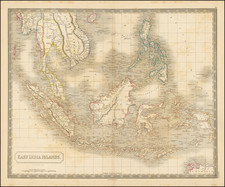
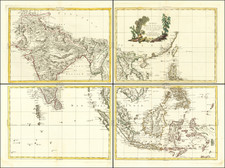
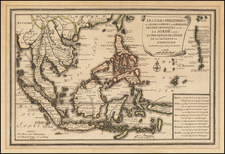
![[ Philippines ] Plan of Solsogon Harbour on the South Coast of Luconia [with] Chart on the Eastern Coast of Bongo Bay in the Island of Mindanao](https://storage.googleapis.com/raremaps/img/small/94791.jpg)
